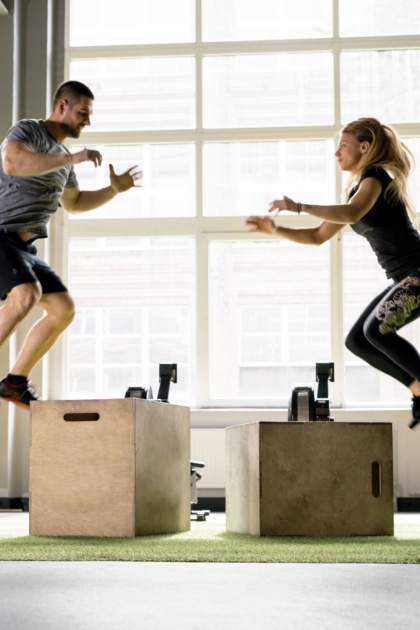
Functional Training in endurance sports
CrossFit, Power Yoga, Freeletics or even Functional Training: the fitness industry is constantly calling for new forms of training and neologisms in order to keep customers happy. What these training systems all have in common is trademarked names and the fact that they claim to be defined programs. Providers of such forms of training pay license fees to the rights holders.
Even the name “Functional Training” is basically a registered trademark, at least when it is offered in a fitness centre. It stands for a cross-sports form of training, which is characterised by complex motion sequences that exercise multiple joints and muscle groups at the same time.
Functional fitness training, on the other hand, is not a protected term, but in the wake of the commercial success of “Functional Training”, is a way of thinking of which athletes and coaches are again becoming increasingly aware: in its most diverse aspects, however, and without any prescribed definitions.
What does functional mean?
Functional fitness training means nothing other than athletes specifically gearing their training towards their sport and predominantly doing things that will advance them in this type of sport. Functional in this context is basically another word for purpose-oriented. A cyclist rides a bike or strengthens and stretches the muscle groups needed for cycling, as do swimmers and runners. A sprinter works on his speed-strength, explosiveness, and technique, a marathon runner on his endurance, foot muscles and long jogs. And while a powerful cardiovascular system is required for a marathon, it would not occur to anyone to do their training exclusively on a bike in the run-up to a competition.
It is most probably a shortcoming that has made this trendy term a focal point for training providers again. This is because in the wake of the endurance sports boom coupled with individualization, many athletes have become frighteningly lopsided. While most of them enjoy running, swimming or cycling in continuous mode on a regular basis and thus train their cardiovascular system, the remaining aspects of fitness such as strength, flexibility, coordination, and speed are often woefully neglected. All the things that coaches in a club used to integrate into the training are barely practised by individual athletes on their own.
When is an exercise functional?
In mass sports in particular, the ultimate goal should not necessarily be a new best time, but to improve versatility, which not only forms the foundation of a good performance, but simultaneously ensures an active life with as few complaints as possible.
Functional can therefore also very simply mean practising forms of movement that are appropriate for the individual demands of everyday life. Functional training for seniors to prevent falls and functional training for a javelin thrower are two completely different matters. And a craftsman probably needs to specifically take care of his core and back muscles in order to withstand the stresses and strains of everyday life.
When applied to recreational sports, functional training focuses on the person’s basic movement pattern. These approaches are not new but were lost over the years and increasingly need to be specifically reactivated and maintained. Rolling, crawling, supporting, pulling, pushing, jumping, bending, lifting, hanging, squatting, standing up, and turning movements - these are all forms of movement that shape people or have shaped them as a child. Anyone who once again moves like a child in a playground (when was the last time you did a somersault or headstand?) or does the prescribed exercises on a vita parcours is in many respects automatically doing functional training.
You just have to do it
Ambitious amateur athletes are naturally predominantly interested in exercises that specifically advance and/or make them faster in their chosen sport. Runners should therefore strengthen their foot and core muscles, cross-country skiers should improve their core and shoulder mobility, and cyclists should stretch their posterior thigh muscles and strengthen their back, neck, and shoulder muscles. And namely before something starts to hurt.
The magic word is not functional training, but versatility. For a long time, there was the deceptive belief that doing more continuous training in a sport also automatically ensured a better performance – and versatility primarily played off its strength in the background by preventing injury and only directly improved performance to a limited extent. It is unfortunately also not the case that when practising a sport, you automatically improve all the joints, muscles and tendons involved if they are challenged. You first need to ensure that you build up resilience by doing well-thought-out and “functional” training.
When it comes to their everyday training activities, athletes should therefore not only consider what they enjoy and therefore automatically do on a regular basis, but also, and most importantly, what they are neglecting but would actually be good for their sport and health. In this sense, it is a personal challenge. Over the next few months, replace one of your weekly training units with a versatile strength, coordination and gymnastics program of the same length as your endurance training. The ideal time to do it is at the end of a sports season and at the beginning of a transition phase. And after these few months, draw a conclusion as to how the changeover has affected your condition. Want to bet that the positive aspects predominate?
Foto:iStock.com
This may be of interest for you too


